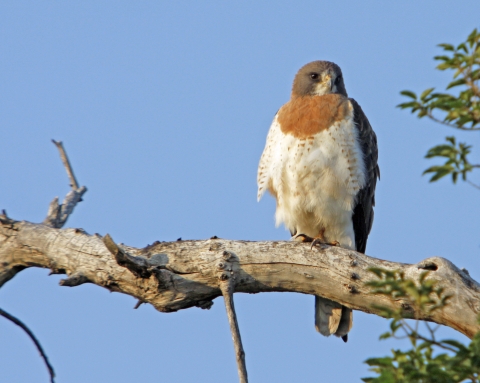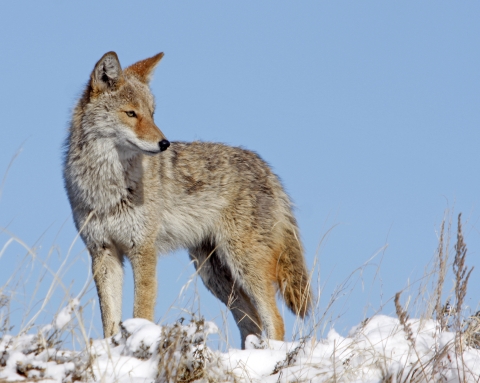
The Refuge’s trail system offer excellent self-guided opportunities to view wildlife in their natural habitat. Wildlife viewing is at its best in the early morning or late afternoon when wildlife is the most active. Be sure to bring your binoculars or camera!
Seasons of Wildlife
Spring
In the spring, the flute-like melody of the western meadowlark can be heard throughout the grasslands. The vesper sparrow, grasshopper sparrow, and Swainson’s hawk can be seen on the prairie. Look for red-tailed hawks sitting in their nests high in the trees or the American kestrel tucked away in a tree cavity awaiting its brood to hatch. Mallards and Canada geese use the Refuge ponds and along the edge in the cattails listen for the calls of the red-winged blackbirds. Great blue herons feed in the mudflats and short marshlands. The Bullock’s oriole, American goldfinch, and yellow warbler are commonly seen throughout the woodland areas. Prairie dog pups venture out of their burrows, and mule and white-tailed deer fawns emerge from thickets.
Summer
Summer brings fields of blooming wildflowers throughout the prairie grasslands. Chorus frogs are abundant in streams and wetlands. Northern leopard frogs, painted turtles, muskrats, and double-crested cormorants drying its outstretched wings can be found in Refuge ponds. Bullsnakes, yellow-bellied racers, and the short-horned lizard make their way through the open prairie grasslands while the black-tailed jackrabbit waits until the late afternoon and evening to feed. In the woodland areas, porcupines can be seen resting in trees, and in the late summer deer and elk are shedding velvet off their antlers.
Fall
In the fall, coyotes lurk around the edges of prairie dog towns well camouflaged in the rust and golden-colored grasses. With their impressive antlers, mule deer, white-tailed deer and elk bucks battle it out for breeding rights. Refuge lakes provide a much-needed stopover for migrating waterfowl. Great horned and long-eared owls can be seen at the base of tree trunks after the leaves have fallen. The onset of winter drawing near is signaled by the arrival of the ferruginous hawk.
Winter
Red-tailed hawks, ferruginous hawks, and prairie falcons circle the winter skies in search of prey, while the Preble’s meadow jumping mouse is safely tucked away hibernating. Elk and deer are foraging in the woodlands and grasslands, while coyotes wait for their prey to emerge from burrows after a snowfall. The rolling hills of the prairie grasslands become dormant as they wait for spring to arrive.




